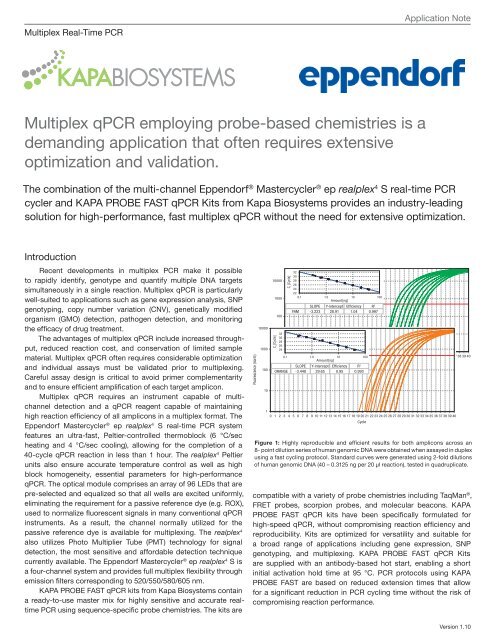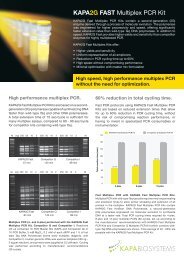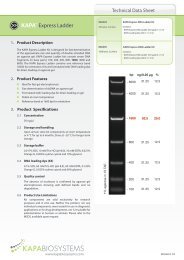KAPA PROBE FAST Eppendorf Multiplex qPCR ... - Kapa Biosystems
KAPA PROBE FAST Eppendorf Multiplex qPCR ... - Kapa Biosystems
KAPA PROBE FAST Eppendorf Multiplex qPCR ... - Kapa Biosystems
Create successful ePaper yourself
Turn your PDF publications into a flip-book with our unique Google optimized e-Paper software.
<strong>Multiplex</strong> Real-Time PCR<br />
Introduction<br />
<strong>KAPA</strong>BIOSYSTEMS<br />
<strong>Multiplex</strong> <strong>qPCR</strong> employing probe-based chemistries is a<br />
demanding application that often requires extensive<br />
optimization and validation.<br />
Recent developments in multiplex PCR make it possible<br />
to rapidly identify, genotype and quantify multiple DNA targets<br />
simultaneously in a single reaction. <strong>Multiplex</strong> <strong>qPCR</strong> is particularly<br />
well-suited to applications such as gene expression analysis, SNP<br />
genotyping, copy number variation (CNV), genetically modified<br />
organism (GMO) detection, pathogen detection, and monitoring<br />
the efficacy of drug treatment.<br />
The advantages of multiplex <strong>qPCR</strong> include increased throughput,<br />
reduced reaction cost, and conservation of limited sample<br />
material. <strong>Multiplex</strong> <strong>qPCR</strong> often requires considerable optimization<br />
and individual assays must be validated prior to multiplexing.<br />
Careful assay design is critical to avoid primer complementarity<br />
and to ensure efficient amplification of each target amplicon.<br />
<strong>Multiplex</strong> <strong>qPCR</strong> requires an instrument capable of multichannel<br />
detection and a <strong>qPCR</strong> reagent capable of maintaining<br />
high reaction efficiency of all amplicons in a multiplex format. The<br />
<strong>Eppendorf</strong> Mastercycler ® ep realplex 4 S real-time PCR system<br />
features an ultra-fast, Peltier-controlled thermoblock (6 °C/sec<br />
heating and 4 °C/sec cooling), allowing for the completion of a<br />
40-cycle <strong>qPCR</strong> reaction in less than 1 hour. The realplex 4 Peltier<br />
units also ensure accurate temperature control as well as high<br />
block homogeneity, essential parameters for high-performance<br />
<strong>qPCR</strong>. The optical module comprises an array of 96 LEDs that are<br />
pre-selected and equalized so that all wells are excited uniformly,<br />
eliminating the requirement for a passive reference dye (e.g. ROX),<br />
used to normalize fluorescent signals in many conventional <strong>qPCR</strong><br />
instruments. As a result, the channel normally utilized for the<br />
passive reference dye is available for multiplexing. The realplex 4<br />
also utilizes Photo Multiplier Tube (PMT) technology for signal<br />
detection, the most sensitive and affordable detection technique<br />
currently available. The <strong>Eppendorf</strong> Mastercycler ® ep realplex 4 S is<br />
a four-channel system and provides full multiplex flexibility through<br />
emission filters corresponding to 520/550/580/605 nm.<br />
<strong>KAPA</strong> <strong>PROBE</strong> <strong>FAST</strong> <strong>qPCR</strong> kits from <strong>Kapa</strong> <strong>Biosystems</strong> contain<br />
a ready-to-use master mix for highly sensitive and accurate realtime<br />
PCR using sequence-specific probe chemistries. The kits are<br />
Application Note<br />
The combination of the multi-channel <strong>Eppendorf</strong> ® Mastercycler ® ep realplex 4 S real-time PCR<br />
cycler and <strong>KAPA</strong> <strong>PROBE</strong> <strong>FAST</strong> <strong>qPCR</strong> Kits from <strong>Kapa</strong> <strong>Biosystems</strong> provides an industry-leading<br />
solution for high-performance, fast multiplex <strong>qPCR</strong> without the need for extensive optimization.<br />
Fluorescence (norm)<br />
10000<br />
10000<br />
1000<br />
100<br />
C t [Cycle]<br />
32<br />
30<br />
28<br />
26<br />
24<br />
22<br />
0.1 1.0 10 100<br />
Amount[ng]<br />
SLOPE Y-intercept Efficiency R 2<br />
FAM -3.223 28.91 1.04 0.997<br />
10 32<br />
30<br />
28<br />
26<br />
1000 24<br />
1<br />
0.1 0 1 2 3 4 5 1.0 6 7 8 9 10 1110 12 13 14 15 16 17 100 18 19202122232425262728293031323334353637383940<br />
Amount[ng]<br />
Cycle<br />
SLOPE Y-intercept Efficiency R<br />
100<br />
2<br />
ORANGE -3.448 29.65 0.95 0.993<br />
10<br />
C t [Cycle]<br />
1<br />
0 1 2 3 4 5 6 7 8 9 10 11 12 13 14 15 16 17 18 19202122232425262728293031323334353637383940<br />
Cycle<br />
Figure 1: Highly reproducible and efficient results for both amplicons across an<br />
8- point dilution series of human genomic DNA were obtained when assayed in duplex<br />
using a fast cycling protocol. Standard curves were generated using 2-fold dilutions<br />
of human genomic DNA (40 – 0.3125 ng per 20 μl reaction), tested in quadruplicate.<br />
compatible with a variety of probe chemistries including TaqMan ® ,<br />
FRET probes, scorpion probes, and molecular beacons. <strong>KAPA</strong><br />
<strong>PROBE</strong> <strong>FAST</strong> <strong>qPCR</strong> kits have been specifically formulated for<br />
high-speed <strong>qPCR</strong>, without compromising reaction efficiency and<br />
reproducibility. Kits are optimized for versatility and suitable for<br />
a broad range of applications including gene expression, SNP<br />
genotyping, and multiplexing. <strong>KAPA</strong> <strong>PROBE</strong> <strong>FAST</strong> <strong>qPCR</strong> Kits<br />
are supplied with an antibody-based hot start, enabling a short<br />
initial activation hold time at 95 °C. PCR protocols using <strong>KAPA</strong><br />
<strong>PROBE</strong> <strong>FAST</strong> are based on reduced extension times that allow<br />
for a significant reduction in PCR cycling time without the risk of<br />
compromising reaction performance.<br />
Version 1.10
<strong>Multiplex</strong> Real-Time PCR<br />
Methods<br />
To demonstrate the ability to perform fast multiplex <strong>qPCR</strong><br />
without compromising reaction efficiencies, a set of eight 2-fold<br />
(Figure 1) or four 4-fold serial dilutions of human genomic DNA<br />
were amplified using either single (Figure 2) or duplex (Figure 3)<br />
assays and a fast cycling protocol (3 min at 95 °C initial activation,<br />
40 cycles of 3 sec at 95 °C and 20 sec at 60 °C). Amplification was<br />
performed in full-skirted <strong>Eppendorf</strong> ® Twin.tec plates with optical<br />
clear heat-sealing film using the realplex 4 S real-time PCR system.<br />
Two hydrolysis probe-based <strong>qPCR</strong> assays were used in this study<br />
(Table 1). Dye calibration for the Cal Fluor ® Gold 540 TaqMan ®<br />
assay was performed as described by Biosearch Technologies.<br />
The resulting log amplification plots and standard curves<br />
for each assay performed separately (Figure 2) and in duplex<br />
(Figure 3) indicate that neither the cycle threshold (C T ), nor the<br />
efficiency of the <strong>qPCR</strong> reactions were compromised as the result<br />
of the multiplex format. The differences in mean C T values (ΔC T )<br />
for each of the four 4-fold dilutions in both the single and duplex<br />
reactions indicate comparable performance between single and<br />
duplex reactions (Table 2). The fast protocol results in a time saving<br />
of 56 min relative to a conventional slow protocol (10 min at 95 °C<br />
initial activation, 40 cycles of 15 sec at 95 °C and 60 sec at 60 °C)<br />
when performed on the realplex 4 S real-time PCR system.<br />
Conclusion<br />
High-performance, multiplex <strong>qPCR</strong> requires a real-time<br />
instrument capable of sensitive multi-channel detection with<br />
excellent block uniformity and a <strong>qPCR</strong> reagent capable of<br />
maintaining high reaction efficiency of all amplicons in a multiplex<br />
format. The combination of <strong>Eppendorf</strong> ® Mastercycler ® ep realplex 4<br />
S real-time PCR system and <strong>KAPA</strong> <strong>PROBE</strong> <strong>FAST</strong> <strong>qPCR</strong> kits provides<br />
an industry-leading solution for high-performance, multiplex <strong>qPCR</strong><br />
without compromising reaction efficiency and reproducibility<br />
relative to single reactions.<br />
Table 1. Reaction parameters used in this study.<br />
Parameter ActB assay ERBB2 assay<br />
Amplicon length 123 bp 124 bp<br />
TaqMan ® fluorophores 5'-FAM / 3'-BHQ ® -1<br />
5'-CAL Fluor ® Gold<br />
540 / 3'-BHQ ® -1<br />
Primer concentration 200 nM each 200 nM each<br />
Probe concentration 50 nM 200 nM<br />
Excitation wavelength 470 nm 470 nm<br />
Emission wavelength 520 nm 550 nm<br />
For more information on the <strong>Eppendorf</strong> ® Mastercycler ® ep realplex 4<br />
S real-time PCR instrument or <strong>Kapa</strong> <strong>Biosystems</strong>' <strong>KAPA</strong> <strong>PROBE</strong><br />
<strong>FAST</strong> <strong>qPCR</strong> Kits please contact your respective local sales<br />
representative or visit:<br />
www.eppendorfna.com and www.kapabiosystems.com.<br />
Fluorescence (norm)<br />
10000<br />
1000<br />
100<br />
C t [Cycle]<br />
32<br />
30<br />
28<br />
26<br />
24<br />
22<br />
0.1 1.0 10 100<br />
Amount[ng]<br />
SLOPE Y-intercept Efficiency R 2<br />
FAM -3.266 28.87 1.02 0.998<br />
Application Note<br />
Table 2. Mean C T values for two targets, ActB and ERBB2, in single and duplex<br />
<strong>qPCR</strong>.<br />
1000<br />
10 32<br />
30<br />
28<br />
26<br />
24<br />
1<br />
0.1 0 1 2 3 4 5 1.0 6 7 8 9 10 1110 12 13 14 15 16 17 100 18 19202122232425262728293031323334353637383940<br />
SLOPE<br />
Amount[ng]<br />
Y-intercept Efficiency R<br />
Cycle<br />
100<br />
2<br />
ORANGE -3.404 29.59 0.97 1<br />
10<br />
C t [Cycle]<br />
1<br />
0 1 2 3 4 5 6 7 8 9 10 11 12 13 14 15 16 17 18 19202122232425262728293031323334353637383940<br />
Cycle<br />
Figure 2: Single <strong>qPCR</strong> reactions. Data showing log amplification plots of a set of four<br />
4-fold serial dilutions of hgDNA ranging from 40 – 0.625 ng per reaction using a fast<br />
2-step cycling protocol. Data represents four replicates for each DNA dilution. The<br />
ActB and ERBB2 assays are shown in green and orange, respectively.<br />
Fluorescence (norm)<br />
Conc. of<br />
human<br />
genomic<br />
DNA<br />
10000<br />
1000<br />
100<br />
10<br />
C t [Cycle]<br />
C t [Cycle]<br />
32<br />
30<br />
28<br />
26<br />
24<br />
22<br />
0.1 1.0 10 100<br />
Amount[ng]<br />
SLOPE Y-intercept Efficiency R 2<br />
FAM -3.223 28.91 1.04 0.997<br />
32<br />
30<br />
28<br />
26<br />
24<br />
22<br />
Duplex<br />
PCR<br />
0.1 1.0 10 100<br />
Amount[ng]<br />
SLOPE Y-intercept Efficiency R 2<br />
FAM -3.448 29.65 0.95 0.993<br />
ActB assay ERBB2 assay<br />
Single<br />
PCR<br />
ΔC T<br />
1<br />
0 1 2 3 4 5 6 7 8 9 10 11 12 13 14 15 16 17 18 19202122232425262728293031323334353637383940<br />
Figure 3: Duplex <strong>qPCR</strong> reactions. Data showing log amplification plots of a set of<br />
four 4-fold serial dilutions of hgDNA ranging from 40 – 0.625 ng per reaction using<br />
a fast 2-step cycling protocol. Data represents four replicates for each DNA dilution.<br />
The ActB and ERBB2 assays are shown in green and orange, respectively.<br />
Trademarks: Mastercycler ® (<strong>Eppendorf</strong> AG); TaqMan ® (Roche Group); Cal Fluor ® and BHQ ® -1<br />
(Biosearch Technologies); FAM (Applera Corporation).<br />
Cycle<br />
Duplex<br />
PCR<br />
Single<br />
PCR<br />
ΔC T<br />
40 ng 24.08 24.29 0.21 22.46 22.75 0.29<br />
10 ng 26.04 26.09 0.05 24.63 24.68 0.05<br />
2.5 ng 27.82 28.17 0.35 26.79 26.76 -0.03<br />
0.3125 ng 30.70 30.67 -0.03 29.58 29.54 -0.04










